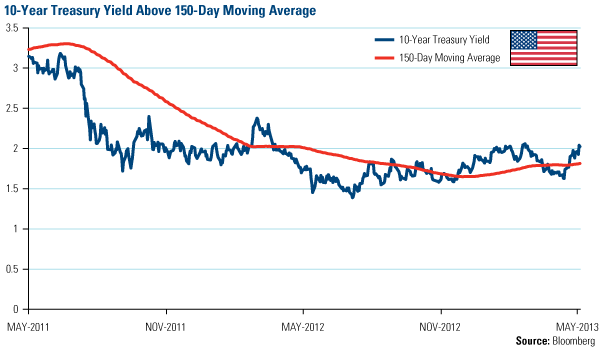The Economy and Bond Market Radar (May 27, 2013)
The benchmark 10-year treasury yield climbed above 2 percent for the first time since March. Investors sold bonds in order to participate in a strong equity market as the S&P 500 stock index reached a new all-time high.
Strengths
- Durable goods orders rose 3.3 percent last month, U.S. Commerce Department data showed, compared with the median forecast of 1.5 percent in a Bloomberg survey. The orders dropped by a revised 5.9 percent in March. Excluding the more volatile transportation equipment component, durable goods orders climbed 1.3 percent, the first gain in three months.
- Existing-home sales rose slightly last month to reach their highest level since late 2009. Total existing home sales increased 0.6 percent to a seasonally adjusted annual rate of 4.97 million in April from an upwardly revised 4.94 million in March, the National Association of Realtors said. At that level, sales were 9.7 percent above year-ago levels.
- The latest University of Michigan current conditions index spiked higher this week. This index gauges consumers' views of their personal finances.
Weaknesses
- The total number of mortgage applications filed in the U.S. last week fell 10 percent from the prior week, as mortgage rates rose to their highest level since March, the Mortgage Bankers Association said Wednesday.
- China's factory activity shrank for the first time in seven months in May as new orders fell, a preliminary manufacturing survey showed, fueling fears that its economic recovery has stalled and that a sharper downturn may be forthcoming.
- Despite growing at a faster-than-expected rate in the first quarter, Taiwan lowered its economic growth forecast for this year among signs that global growth is faltering.
Opportunity
- The Federal Reserve continues to remain committed to an extremely accommodative policy.
- Key global central bankers, such as the ECB, Bank of England and the Bank of Japan, are still in easing mode. The Bank of Japan in particular is aggressively easing and the ECB recently cut interest rates.
Threat
- Inflation in some corners of the globe is getting the attention of policy makers and may be an early indicator for the rest of the world.
- Trade and/or currency “wars” cannot be ruled out, which may cause unintended consequences and volatility in the financial markets.










